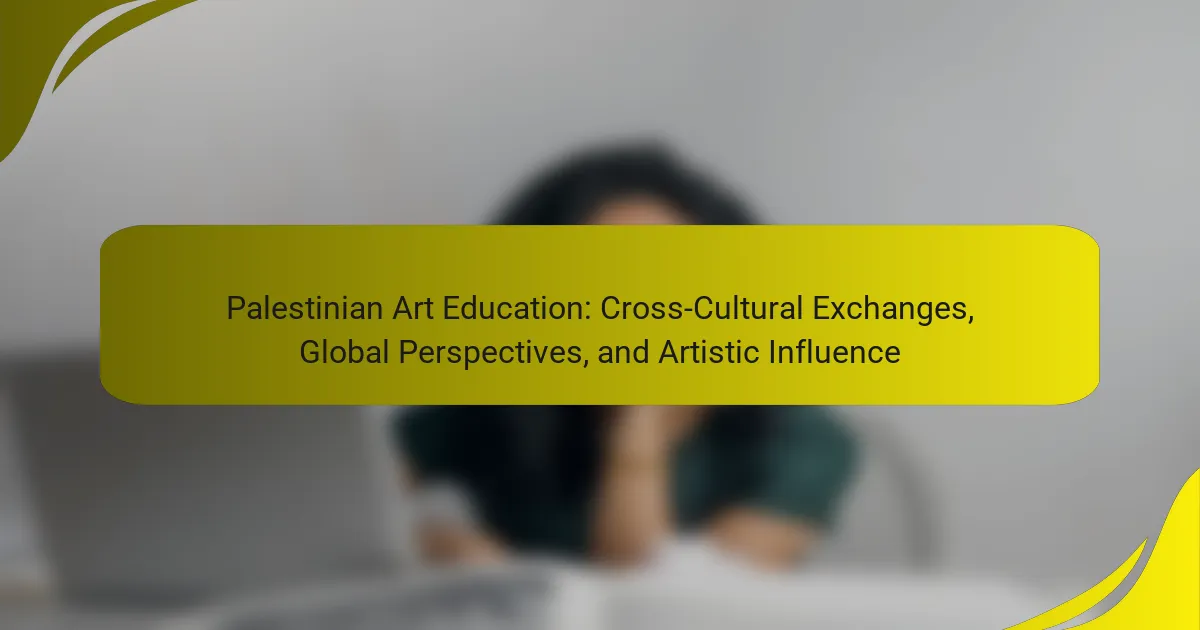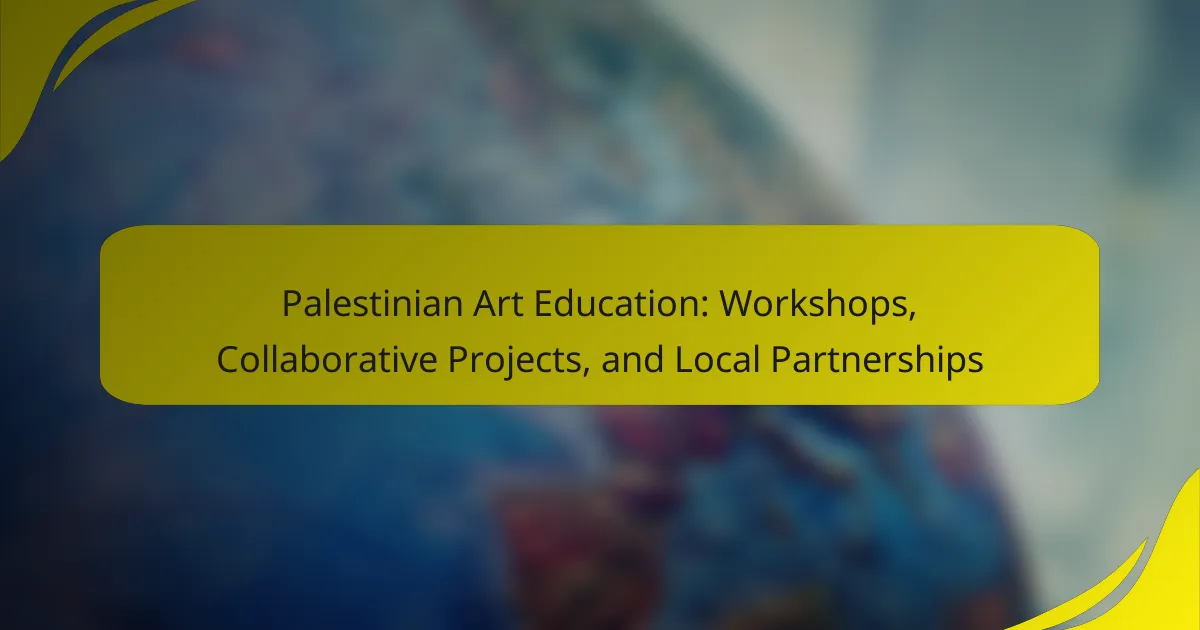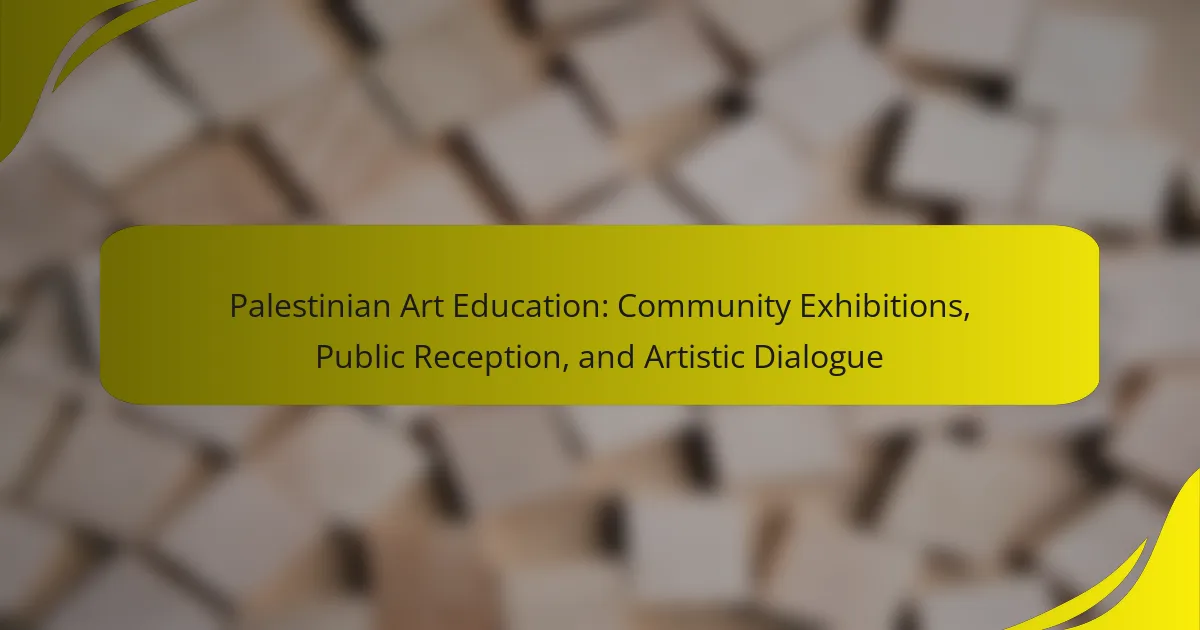Palestinian Art Education is a system dedicated to teaching and learning artistic expression within Palestinian culture, encompassing visual arts, music, and performance. This educational framework aims to promote cultural identity and heritage among Palestinian youth while addressing historical and social issues faced by the community. Through workshops, exhibitions, and collaborative projects, Palestinian Art Education fosters creativity, critical thinking, and personal expression. It serves as a platform for dialogue and resistance against cultural erasure, strengthening social cohesion and contributing to the broader narrative of resilience among Palestinians. Additionally, research highlights the positive impact of art education on academic performance and community dynamics.
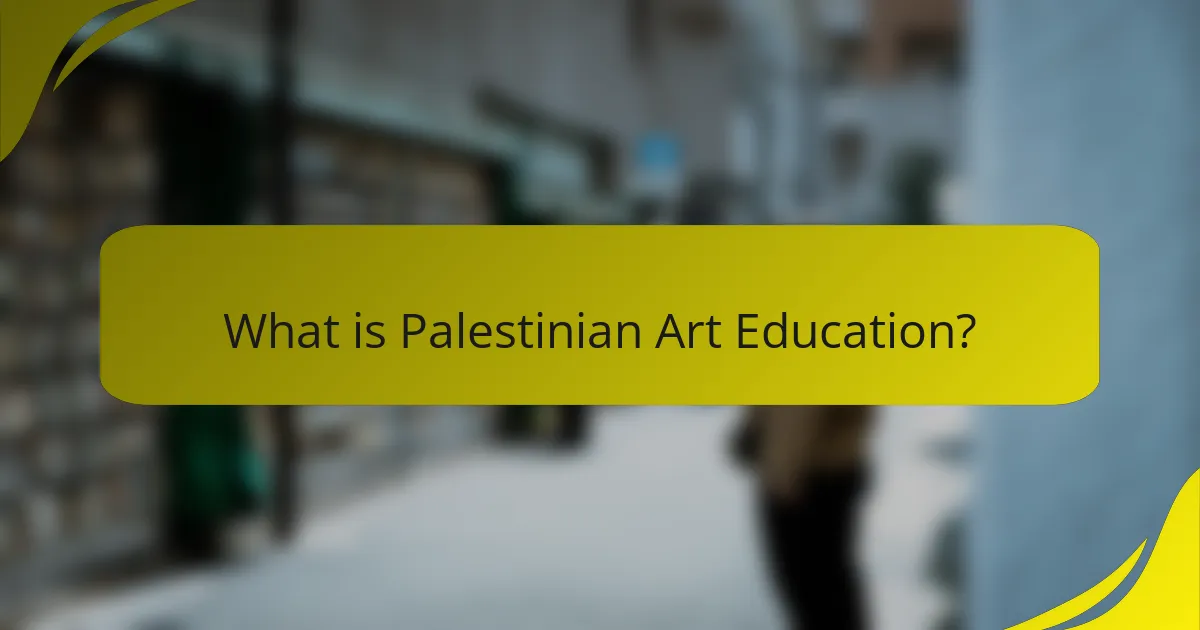
What is Palestinian Art Education?
Palestinian Art Education is a system of teaching and learning focused on artistic expression within Palestinian culture. It encompasses various forms of visual arts, music, and performance. This education aims to promote cultural identity and heritage among Palestinian youth. It often takes place in schools, community centers, and universities. Palestinian Art Education is influenced by historical events and social issues faced by the Palestinian people. Programs may include workshops, exhibitions, and collaborative projects. Studies indicate that art education fosters creativity and critical thinking. It also serves as a means of resistance and empowerment for the community.
How has Palestinian Art Education evolved over time?
Palestinian Art Education has evolved significantly from traditional practices to contemporary approaches. Initially, art education focused on local crafts and cultural heritage. Over time, it incorporated modern techniques and global influences. The establishment of institutions like the Palestine Polytechnic University in 1970 marked a pivotal change. These institutions began offering structured art programs. In the 1990s, the Oslo Accords facilitated greater cultural exchange and collaboration with international art communities. Today, Palestinian Art Education emphasizes both local identity and global perspectives. The rise of digital media has also transformed teaching methods and outreach. This evolution reflects a broader societal resilience and the importance of art in cultural expression.
What historical events have influenced Palestinian Art Education?
Palestinian Art Education has been influenced by several historical events. The Nakba in 1948 led to the displacement of Palestinians, affecting cultural expression. The Israeli occupation, beginning in 1967, restricted access to resources and opportunities for artistic development. The First Intifada in 1987 sparked a resurgence in cultural identity, promoting art as a form of resistance. The Oslo Accords in the 1990s introduced limited autonomy, impacting educational institutions. The ongoing conflict continues to shape artistic narratives and educational frameworks. These events collectively inform the themes, styles, and pedagogical approaches in Palestinian art education today.
How do traditional practices shape contemporary Palestinian Art Education?
Traditional practices significantly influence contemporary Palestinian Art Education. They provide a foundation for artistic expression and cultural identity. Many art educators incorporate traditional techniques into their curricula. This integration helps preserve cultural heritage among younger generations. For instance, practices like embroidery and pottery are often included in art programs. These traditional forms offer students a connection to their history. Additionally, they foster a sense of belonging and pride within the community. Research shows that engaging with traditional art enhances students’ understanding of their cultural narratives. Such educational approaches ensure that the legacy of Palestinian art continues to thrive.
What are the key components of Palestinian Art Education?
The key components of Palestinian Art Education include cultural expression, historical context, and community engagement. Cultural expression allows students to explore their identity through various art forms. Historical context provides insight into the rich heritage and struggles of the Palestinian people. Community engagement fosters collaboration and support among artists and educators. These components collectively enhance artistic skills and promote social awareness. Art education in Palestine often integrates traditional techniques with contemporary practices. This blend encourages innovation while respecting cultural roots. Additionally, art education serves as a means of resistance and empowerment for the community.
What types of art are emphasized in Palestinian Art Education?
Palestinian Art Education emphasizes various forms of artistic expression. These include visual arts, such as painting and sculpture. Traditional crafts like embroidery and pottery are also highlighted. Additionally, performance arts, including theater and dance, play a significant role. The curriculum often incorporates cultural heritage themes. This approach fosters a sense of identity and community among students. Engaging with these art forms helps preserve Palestinian culture. It also encourages critical thinking and creativity in learners.
How do educational institutions contribute to Palestinian Art Education?
Educational institutions contribute to Palestinian Art Education by providing structured programs and resources for artistic development. They offer courses in various art forms, including visual arts, music, and theater. These institutions create platforms for local artists to showcase their work. They also facilitate workshops and exhibitions that promote cultural heritage. Furthermore, educational institutions often collaborate with international organizations to enhance art education. This collaboration can lead to increased funding and resources. By fostering creativity, they empower students to express their identities. This empowerment is crucial in a context where cultural expression is often challenged.
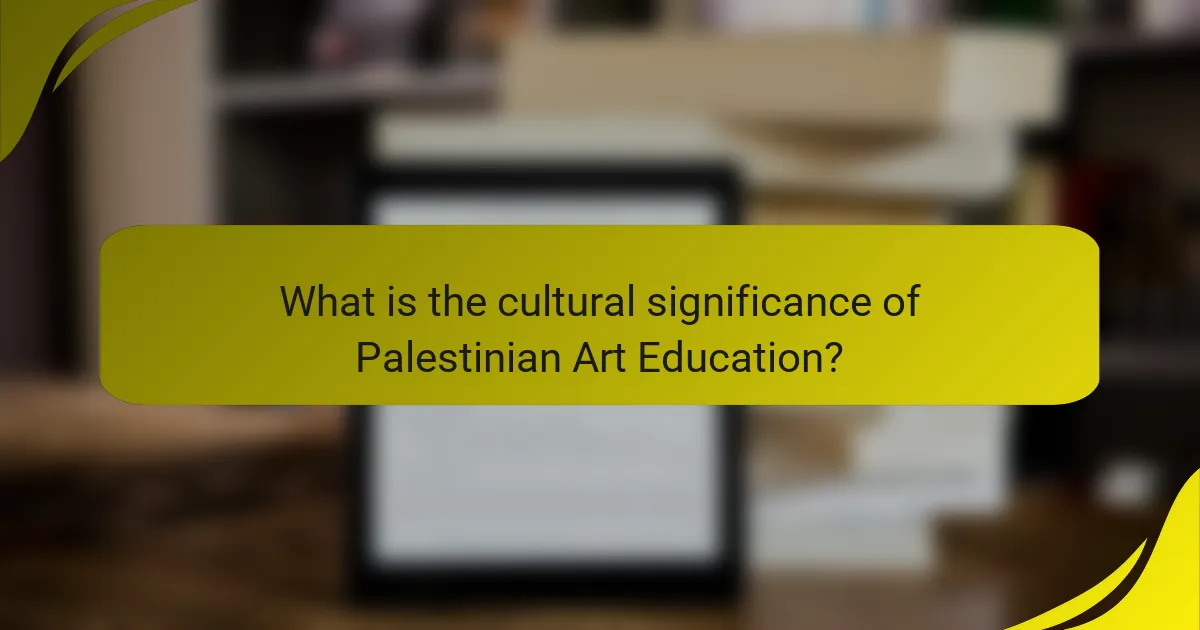
What is the cultural significance of Palestinian Art Education?
Palestinian Art Education holds significant cultural importance as it serves as a means of preserving and expressing Palestinian identity. This educational framework fosters creativity and critical thinking, encouraging students to engage with their cultural heritage. Furthermore, it provides a platform for dialogue and resistance against cultural erasure. Art education in Palestine often reflects the socio-political realities faced by its people, making it a powerful tool for advocacy and social change. Through various art forms, students learn to articulate their experiences and perspectives. This process helps to cultivate a sense of community and solidarity among Palestinians. Moreover, Palestinian Art Education contributes to the broader narrative of resistance and resilience in the face of adversity.
How does Palestinian Art Education reflect cultural identity?
Palestinian art education reflects cultural identity by integrating traditional themes and contemporary issues. It emphasizes the historical narratives of Palestine through various artistic expressions. Students learn to explore their heritage, fostering a sense of belonging and pride. Art serves as a medium to communicate social and political realities faced by Palestinians. Programs often include motifs from Palestinian folklore and history, reinforcing cultural continuity. Research shows that engaging with local art enhances cultural awareness among students. This connection to identity is crucial in a context of ongoing conflict and displacement. Thus, Palestinian art education acts as a vital tool for cultural preservation and expression.
In what ways does art serve as a form of resistance in Palestinian culture?
Art serves as a form of resistance in Palestinian culture by expressing identity and challenging oppression. It provides a medium for storytelling that reflects the Palestinian experience. Artists use visual art, music, and literature to convey messages of resilience. This form of expression often critiques political situations and highlights social injustices. For example, graffiti and murals in Palestinian territories depict themes of struggle and hope. These artworks foster community solidarity and inspire activism. Cultural events and festivals celebrate Palestinian heritage through artistic expression. This resistance through art maintains cultural continuity despite external pressures.
What role do artists play in preserving Palestinian heritage?
Artists play a crucial role in preserving Palestinian heritage. They express cultural identity through various art forms such as painting, music, and dance. Their work often reflects historical narratives and social issues faced by Palestinians. Artists also engage communities, fostering a sense of belonging and continuity. Through exhibitions and performances, they share Palestinian stories with wider audiences. This promotes awareness and appreciation of Palestinian culture globally. Furthermore, artists document traditional practices, ensuring their transmission to future generations. Their contributions help maintain cultural resilience amid challenges.
How does Palestinian Art Education impact community engagement?
Palestinian art education fosters community engagement by promoting cultural identity and social cohesion. It provides a platform for individuals to express their experiences and narratives. Art education encourages collaboration among diverse community members. Workshops and exhibitions often bring together artists and non-artists alike. This interaction cultivates a sense of belonging and shared purpose. Additionally, art initiatives can address social issues, sparking dialogue and awareness. Research shows that community art projects enhance local participation and pride. For instance, initiatives like the “Palestinian Art Academy” have successfully engaged youth in meaningful artistic practices. These programs not only develop skills but also strengthen community ties.
What initiatives promote community involvement in art education?
Community involvement in art education is promoted through various initiatives. Local art programs often engage residents in workshops and exhibitions. These programs encourage participation from diverse age groups. Schools collaborate with community artists to enhance curricula. Non-profit organizations frequently host events to raise awareness and funds. Art festivals provide platforms for showcasing local talent. Community centers offer classes to foster artistic skills. Public art projects invite community input and collaboration. These initiatives strengthen cultural ties and enhance educational opportunities.
How does art education foster social cohesion among Palestinians?
Art education fosters social cohesion among Palestinians by promoting shared cultural identity and community engagement. It provides a platform for expression and dialogue among diverse groups. Through collaborative projects, individuals build relationships and mutual understanding. Art education also encourages the exploration of collective history and heritage. This process strengthens community ties and fosters empathy. Programs in schools and community centers often include participants from various backgrounds. These interactions create a sense of belonging and unity. Furthermore, art initiatives often address social issues, raising awareness and inspiring collective action. Overall, art education serves as a vital tool for healing and solidarity within Palestinian society.

What are the benefits of Palestinian Art Education for individuals and society?
Palestinian Art Education offers numerous benefits for individuals and society. It enhances personal expression and creativity among students. This form of education fosters cultural identity and awareness. It plays a crucial role in preserving Palestinian heritage. Art education also promotes critical thinking and problem-solving skills. Social cohesion is strengthened through collaborative art projects. Furthermore, it provides a platform for dialogue and understanding within communities. Research indicates that art education can improve academic performance across various subjects. In summary, Palestinian Art Education enriches both individual lives and societal dynamics.
What skills do students gain from participating in Palestinian Art Education?
Students gain various skills from participating in Palestinian Art Education. These skills include creativity, critical thinking, and cultural awareness. Students learn to express their thoughts and emotions through various art forms. They develop problem-solving abilities while creating art projects. Collaboration skills are enhanced through group activities and discussions. Students also gain technical skills related to different artistic mediums. Additionally, they cultivate an appreciation for their cultural heritage. This education fosters resilience and adaptability in challenging environments.
How does participation in art education enhance personal development?
Participation in art education enhances personal development by fostering creativity, critical thinking, and emotional expression. Engaging in artistic activities encourages individuals to explore their thoughts and feelings. This exploration often leads to improved self-awareness and confidence. Studies show that art education can increase problem-solving skills. For instance, a report by the Arts Education Partnership highlights that students involved in the arts demonstrate higher academic performance. Additionally, art education promotes social skills through collaboration and teamwork. These interactions help build empathy and communication abilities. Overall, art education serves as a vital tool for holistic personal growth.
What are the long-term benefits of art education on community well-being?
Art education fosters long-term community well-being by enhancing social cohesion and cultural identity. It encourages collaboration among individuals, leading to stronger community bonds. Art initiatives often provide platforms for dialogue and expression, reducing social tensions. Studies show that communities with robust art programs experience lower crime rates and improved mental health. For instance, a report by the National Endowment for the Arts indicates that art education positively impacts community engagement and civic participation. Furthermore, art education contributes to economic development by attracting tourism and supporting local artists. Overall, the integration of art education into communities cultivates resilience and fosters a sense of belonging.
How can individuals support Palestinian Art Education initiatives?
Individuals can support Palestinian Art Education initiatives by donating to organizations that focus on art programs in Palestine. These donations provide essential funding for workshops, supplies, and educational resources. Participating in art auctions or exhibitions that benefit Palestinian artists also helps raise funds and awareness. Volunteering time or skills to local art initiatives can enhance program offerings and community engagement. Sharing information about Palestinian art education on social media amplifies visibility and encourages others to contribute. Supporting Palestinian artists directly through purchases of their work fosters economic sustainability in the art community. Collaborating with established organizations can also create more impactful programs and outreach efforts.
What are effective ways to contribute to local art education programs?
Support local art education programs by volunteering time and skills. Offer to teach art classes or workshops. Donations of art supplies can greatly benefit these programs. Collaborate with local artists to enhance educational offerings. Fundraising events can raise necessary resources for art initiatives. Partner with schools to integrate art into the curriculum. Research shows that art education fosters creativity and critical thinking in students. According to a report by the Arts Education Partnership, students engaged in the arts perform better academically.
How can awareness of Palestinian Art Education be raised globally?
Awareness of Palestinian Art Education can be raised globally through targeted campaigns and collaborations. Organizing international art exhibitions showcasing Palestinian artists can attract global attention. Utilizing social media platforms allows for widespread sharing of educational content. Partnering with global art institutions can facilitate cultural exchanges and workshops. Engaging art influencers to promote Palestinian art can amplify its reach. Creating online courses about Palestinian art history can educate a broader audience. Supporting local artists through grants can enhance their visibility globally. Promoting documentaries and films about Palestinian art can further raise awareness.
Palestinian Art Education is a system that emphasizes artistic expression within Palestinian culture, incorporating various forms of visual arts, music, and performance to promote cultural identity among youth. The article explores its historical evolution, influenced by significant events such as the Nakba and the Israeli occupation, while highlighting the integration of traditional practices with contemporary approaches. Key components include community engagement and the role of educational institutions in fostering creativity and social cohesion. Additionally, the article discusses the impact of art education on personal development and community well-being, and outlines ways individuals can support these initiatives globally.
